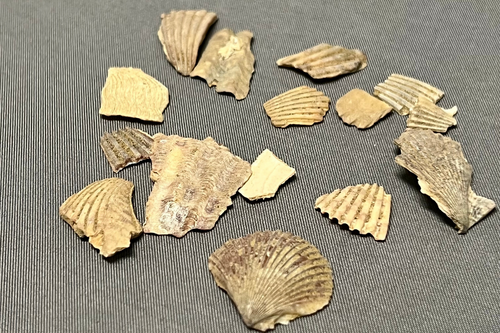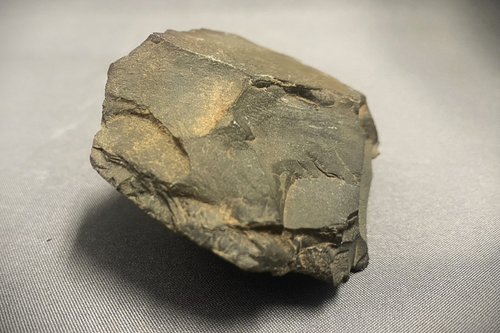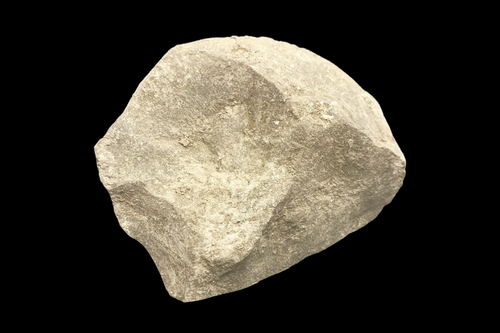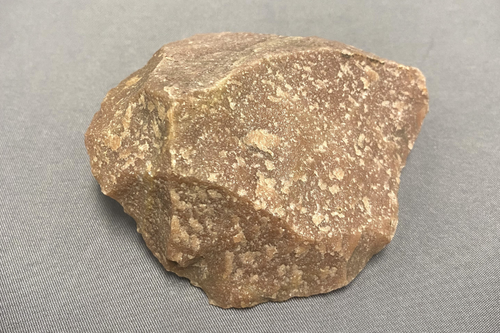
New Acquisitions: SDAC 752
Take a behind-the-scenes peak at our most recently acquired collections in our virtual exhibit New Acquisitions. To accompany this exhibit, each month the SDAC social media and collections blog New Acquisitions: A Closer Look will take a closer look at the collections that are being curated, the research value they provide, and the importance of archaeology in San Diego County.
The San Diego Archaeological Center houses many prehistoric and historic collections from the San Diego County adjacent regions. The Center is equipped with over 5,000 square feet of vault space that allow us to provide long-term curation and care for a wide range of archaeological materials, including artifacts, ecofacts, maps, photographs, and site records. Partnering with local colleges and universities provides a setting for volunteers and students interested in archaeology to gain hands-on experience working with archaeological collections.
How Does the SDAC Acquire New Collections?
Most of the collections that are curated at the Center come to us from Cultural Resource Management (CRM) firms. These CRM firms work with developers and homeowners from around the county to make sure that construction is done using ethical and sustainable methods and that archaeological sites are protected and documented. Once their work is complete, CRM firms transfer titles for permanent curation of collections at the Center for long-term preservation and care.
What is in a Collection?
New collections delivered to the Center have many pieces. They must contain a site report, master catalog of curated objects, information about inadvertent discoveries, and other supplemental documentation such as field notes, maps, and photographs.
SDAC 752 – Delivered August 9th, 2022
Project Name: Spindrift Site
Site(s): CA-SDI-39
USGS Quad Location: La Jolla 7.5’
Year of Excavation: 2021-2022
This collection consists of another project from the La Jolla neighborhood in the city of San Diego encompassing the Spindrift Site, which is well known to archaeologists as a large prehistoric occupation site. We receive many collections at the SDAC from within this site boundary. Another project from this same neighborhood was accessioned as SDAC 750, which you can read about in our New Acquisitions exhibit.
It is common best practice for archaeologists beginning a new project to review findings from past projects before they begin their work at a well-documented (and any previously recorded) site. The Spindrift Site is well-known by archaeologists and has been actively documented over the years due to the many developments that have occurred. It has been previously recorded as a prehistoric village that dates from the Early Archaic La Jolla Complex through the Late Prehistoric Period. Archaeologists know that being the large village that it was, human remains are likely to be found, so each project must be well-documented and tested to not disturb any sacred grounds.
The private residence within this site boundary was looking to do a remodel, and because of the known significance and sensitivity of the Spindrift Site, archaeologists were onsite during all phases including the soil disturbance. Kumeyaay Native American monitors from Red Tail Environmental were also onsite for all phases.
Much of the SDI-39 site’s development took place in the early 20th century, before archaeological sites were protected by California laws, and therefore, has unfortunately been heavily disturbed. It is known that this site was occupied for many different purposes, and by studying the cultural resources recovered during development, archaeologists can continue to infer how people lived here thousands of years ago.
During the testing phase of this project, it was determined that the soil in the project boundary was heavily disturbed during past construction, likely before and during the creation of the original property. The area of the property where the project occurred was not thought to have archaeological value nor significance because of its lacking provenience from the disturbances. The previous disturbances mixed with fill soil and did not leave a lot for archaeologists to find that would have led to dating or research value.
The soil that was disturbed by this project was sorted (cultural and non-cultural), and the soil containing cultural materials was dry screened on site using 1/8-inch hardwire mesh screens. The recovered cultural material was then transferred to the archaeological lab for cleaning, sorting, and analysis. All soil was transferred back to the property and will remain there indefinitely.
During the different phases of this project, the recovered cultural resource material types identified were unmodified and modified bone, ceramic, chipped stone, ground stone, and unmodified and modified shell.

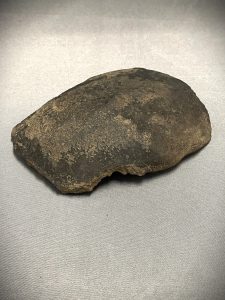
Pottery
Among the forty-seven cultural resources found and collected from this testing phase of the project, Tizon brownware ceramics were recovered, which can at the very least date this portion of the site to at least Late Prehistoric since we know that was not prevalent in this area before then. Overall, 533 prehistoric ceramic resources were recovered, all consisting of the Tizon brownware material. Archaeologists were able to infer that the coil method of production was used to make some of the pottery. The paddle and anvil technique were also recognized upon microscopic analysis. Other than this partial dating, archaeologists did not expect to advance research for this site once they determined that it was disturbed and lacking provenience.
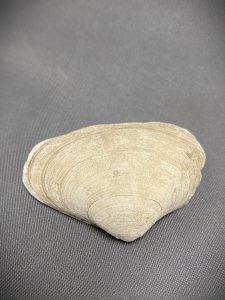
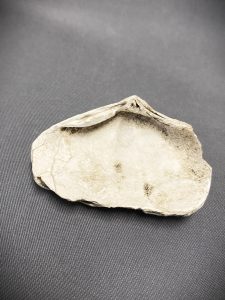
Shell
During the monitoring program phase of the project, 1,353 cultural resources were collected. The range of material classes and types of artifacts found in the SDI-39 boundaries imply that some of the site activities included deep-water fishing; use and creation of fishing gear, basketry, projectile points and shafts, and shell beads; and use and potential manufacture of ceramics and bone tools. Many of these types of cultural resources lead us to believe the people living at the SDI-39 site were possibly participating in trade with other communities.

The types of shell found at an archaeological site can determine the environment during the time it was being inhabited. The shell recovered during the Spindrift Project of 2021-2022 was all a part of the mollusk family, with Tivela sp. (or saltwater clams) accounting for more than half of the identifiable species.
It is important to consider factors such as the movement of the coastline when examining the relationship between the environment and the people living in it. This Haliotis sp. shell would have been used for more than just food consumption; it likely had ornamental purposes as well, which may be a trade indicator. Eleven thousand years ago, the last period of glaciation occurred, and the sea level was much lower than it is today. The coastline is thought to have been 2 to 2.5 miles further west.
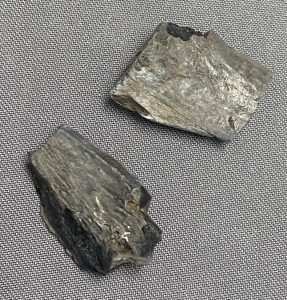
Animal Bone
A single bone tool was identified during this project, but its use is unknown. The archaeologists were unable to determine what it was used for but know that it was part of the foot and likely from a deer. In past excavations of this site, modified bones have been identified and tool technologies documented in so it was not surprising for archaeologists to find this fragment.

Lithics
The lithics that were found vary widely in type and function. An interesting tool type that was recovered is the adze. An adze is a type of scraper tool, or SEUT, that was specifically used for woodworking. Adzes are sharp and heavy and have strong cutting edges.
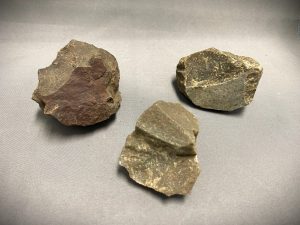
Cores recovered from this project suggest that they had been used to their full potential, judging by their small size. It was likely that these cores had been worked, reworked, and recycled as many times as possible. Archaeologists looked at the cores recovered from this project and compared them to those from past projects. They have similar reduction approaches and “represent an interrelated system of nodule core technologies, biface manufacturing technologies, and arrow point manufacture and rejuvenation previously established at other portions of this large site.”[1]

Replacing the atlatl and dart, the bow and arrow required smaller points. The bow and arrow have been used for an estimated 1500 years in San Diego County. These points date the site as being occupied at least 1500 years ago, and the range of different types of points (like this point) are indicative of SDI-39 being a habitation site rather than a hunting site. It was determined that the knapping or stone tool production activities at this location included the production of flake blanks (from the nodule cores) and the manufacturing of arrow points.
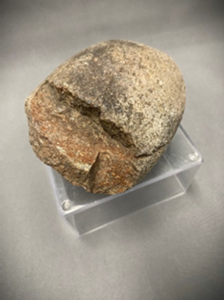
Ground Stone
The ground stone identified during this project included manos with grinding patterns that suggest primary use with shallow basin metates.
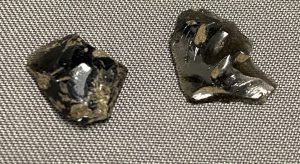
Dating the Site
One way archaeologists may date a site is by finding obsidian and sourcing it. Obsidian is not found locally in San Diego County. The two sources closest to the area are in Imperial County and Kern County. Obsidian debitage that was found was analyzed under microscope. All the obsidian observed was identified as Obsidian Butte, which is the type sourced from Imperial County. Archaeologists know that Obsidian Butte is associated with the Late Period occupation, rather than the Kern County obsidian (or Coso Volcanic) associated with the Early Period occupation.
Summary of Project
As a well-known and significant site in the La Jolla area of San Diego County, any project occurring within the SDI-39 boundary lines is investigated thoroughly before and during any construction or development. While much of the site was heavily disturbed, archaeologists diligently look at recovered material to find if context and integrity remain before allowing further disturbance to occur. This area of SDI-39 was heavily disturbed prior to the construction of the residence in 1929, but the cultural materials and resources that were recovered suggest the prior excavations claims of this being a large habitational and coastal site. The types of cultural resources lead archaeologists to infer that the site was used for long-term occupation, and activities varied from hunting, fishing, and the manufacture of tools.
To learn more about this collection or if you have any questions regarding the acquisitions at the Center, please email collections@sandiegoarchaeology.org
Come back next month as we take a closer look at SDAC 753, a project excavated between 2020 and 2022 in the Point Loma area.
By Jessica McPheters, Collections Manager
Reference
The following report was used for the analysis of this collection:
Conroy, Jillian L.H., and Brian F. Smith. Poway, CA, 2022, Mitigation Monitoring and Reporting Program for the **** Project, La Jolla, California.
[1] Conroy, Jillian L.H., and Brian F. Smith. Poway, CA, 2022, Mitigation Monitoring and Reporting Program for the **** Project, La Jolla, California.


